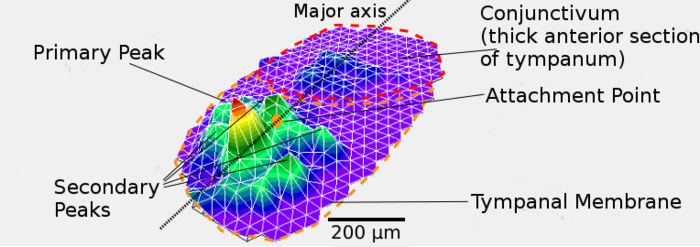CHICAGO, May 10, 2023 – What can an insect hear? Surprisingly, quite a lot. Though small and simple, their hearing systems are highly efficient. For example, with a membrane only 2 millimeters across, the desert locust can decompose frequencies comparable to human capability. By understanding how insects perceive sound and using 3D-printing technology to create custom materials, it is possible to develop miniature, bio-inspired microphones.

Credit: Andrew Reid
CHICAGO, May 10, 2023 – What can an insect hear? Surprisingly, quite a lot. Though small and simple, their hearing systems are highly efficient. For example, with a membrane only 2 millimeters across, the desert locust can decompose frequencies comparable to human capability. By understanding how insects perceive sound and using 3D-printing technology to create custom materials, it is possible to develop miniature, bio-inspired microphones.
Andrew Reid of the University of Strathclyde in the U.K. will present his work creating such microphones, which can autonomously collect acoustic data with little power consumption. His presentation, “Unnatural hearing — 3D printing functional polymers as a path to bio-inspired microphone design,” will take place Wednesday, May 10, at 10:05 a.m. Eastern U.S. in the Northwestern/Ohio State room, as part of the 184th Meeting of the Acoustical Society of America running May 8-12 at the Chicago Marriott Downtown Magnificent Mile Hotel.
“Insect ears are ideal templates for lowering energy and data transmission costs, reducing the size of the sensors, and removing data processing,” said Reid.
Reid’s team takes inspiration from insect ears in multiple ways. On the chemical and structural level, the researchers use 3D-printing technology to fabricate custom materials that mimic insect membranes. These synthetic membranes are highly sensitive and efficient acoustic sensors. Without 3D printing, traditional, silicon-based attempts at bio-inspired microphones lack the flexibility and customization required.
“In images, our microphone looks like any other microphone. The mechanical element is a simple diaphragm, perhaps in a slightly unusual ellipsoid or rectangular shape,” Reid said. “The interesting bits are happening on the microscale, with small variations in thickness and porosity, and on the nanoscale, with variations in material properties such as the compliance and density of the material.”
More than just the material, the entire data collection process is inspired by biological systems. Unlike traditional microphones that collect a range of information, these microphones are designed to detect a specific signal. This streamlined process is similar to how nerve endings detect and transmit signals. The specialization of the sensor enables it to quickly discern triggers without consuming a lot of energy or requiring supervision.
The bio-inspired sensors, with their small size, autonomous function, and low energy consumption, are ideal for applications that are hazardous or hard to reach, including locations embedded in a structure or within the human body.
Bio-inspired 3D-printing techniques can be applied to solve many other challenges, including working on blood-brain barrier organoids or ultrasound structural monitoring.
###
———————– MORE MEETING INFORMATION ———————–
Main meeting website: https://acousticalsociety.org/asa-meetings/
Technical program: https://eppro02.ativ.me/web/planner.php?id=ASASPRING23&proof=true
ASA PRESS ROOM
In the coming weeks, ASA’s Press Room will be updated with newsworthy stories and the press conference schedule at https://acoustics.org/asa-press-room/.
LAY LANGUAGE PAPERS
ASA will also share dozens of lay language papers about topics covered at the conference. Lay language papers are summaries (300-500 words) of presentations written by scientists for a general audience. They will be accompanied by photos, audio, and video. Learn more at https://acoustics.org/lay-language-papers/.
PRESS REGISTRATION
ASA will grant free registration to credentialed and professional freelance journalists. If you are a reporter and would like to attend the meeting or virtual press conferences, contact AIP Media Services at [email protected]. For urgent requests, AIP staff can also help with setting up interviews and obtaining images, sound clips, or background information.
ABOUT THE ACOUSTICAL SOCIETY OF AMERICA
The Acoustical Society of America (ASA) is the premier international scientific society in acoustics devoted to the science and technology of sound. Its 7,000 members worldwide represent a broad spectrum of the study of acoustics. ASA publications include The Journal of the Acoustical Society of America (the world’s leading journal on acoustics), JASA Express Letters, Proceedings of Meetings on Acoustics, Acoustics Today magazine, books, and standards on acoustics. The society also holds two major scientific meetings each year. See https://acousticalsociety.org/.
###




